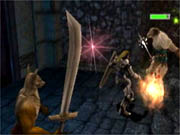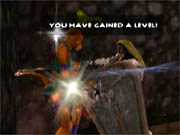
Shifters is the successor to 3DO's poorly received Warriors of Might and Magic, and this fact is immediately apparent in a number of ways. Its predecessor, which was among the PS2's earliest third-person action adventure games, was regarded as one of the system's worst games around the time of its launch. Sadly, Shifters doesn't fare much better. The game attempts to create huge, living game environments, and it tries its best to set you free in them with a character-development system that's versatile in theory and interestingly designed. But the fulfillment of both of these ambitions is unfortunately stymied by shoddy production values and half-baked game mechanics. As was the case with its predecessor, Shifters was clearly not given enough time in development, and it isn't fun to play as a result.
Remember Alleron from the original game? Maybe not, but he's back again, demonic mask and all, as the main character of Shifters. Though, in truth, you won't spend all that much time playing as him. The game's title refers to Alleron's ability to shape-shift into a variety of forms, both monstrous and fantastical--everything from savage beastmen and undead liches to weird extradimensional aliens and mechanized aberrations. These forms are grouped into six broad categories, each representing a basic type of creature: bestials, genies, undead, kreegan, hybrids, and automata. Bestials are basically animal men, genies include the common blue-skinned, bearded stereotypes, and the undead are ancient-Egyptian-style animated corpses. The last three are a bit stranger--the kreegan are extradimensional horrors, while the hybrids are half-human mechanoid monstrosities. Automata are basically steam-powered robots, ranging from weak, stilt-legged grunts to vicious, blade-armed killing machines.

Each of these "species" has four subforms, and accessing them requires allocating "form points" that you find scattered throughout the game's worlds. You'll start out as a "grunt" in each respective form, eventually evolving to a "shaman" and, finally, to either a "mage" or a "warlord." You're allowed to choose which form to take in the third phase, with the former emphasizing the species' magical abilities and the latter leaning toward physical combat. The way each of your forms looks actually changes as you evolve through a species' ranks, too. As a bestial grunt, you'll look like a brutish, ram-headed creature, though when you evolve into the warlord, you'll take the form of a proud, elephantine behemoth. Some species will have basic abilities that are unique to them--the undead, for instance, regenerate health over time and are immune to poisonous gas, while genies can assume a mist form that allows you to pass through gated barriers. Each subform, further, grants you new spell-like abilities, most of which are straightforwardly offensive and some of which you combat bonuses. Still others have more abstract--and, more often than not, only partially functional--effects.
Some of the forms you can transform into actually look rather cool, and the abilities unique to them can seem quite distinct, at times. And the whole idea of shape-shifting seems like a good one. But this is all cheapened by one key fact--throughout the game, the enemies you'll encounter will actually be the very same creatures that you can morph into. You'll fight bestials of all forms in the first world, while undead, genies, and kreegan will reign supreme in the second. The last will have you battling it out with hybrids and automata, but by then, it will all have gotten old long ago. It will seem to you at first that hordes of unique creatures are attacking you from all sides, but the reality of the situation soon sinks in, as you'll find yourself fighting the same monsters over and over. You'll find the enemies casting the very same spells at you that you yourself can cast at them, though their physical attacks are much simpler than yours. The AI for these creatures is sometimes laughable, as you'll find enemies stuck running into corners and doing all sorts of other brain-dead things.
Though 3DO advertises that the game has more than 30 levels, in reality, you'll only get to play through three distinct environments, each with sloppily implemented level transitions scattered throughout them. You'll be walking down a hall, for example, when an onscreen prompt will pop up, asking you if you want to load the next level. Select "yes," and you'll have to wait for 30 seconds before continuing down the same hallway. And if a monster smacks you a few feet back, you'll get the prompt again. Each of the three worlds, such as they are, also has a town section somewhere in it, allowing you to talk to townsfolk, shop for items, and generally explore an area without the threat of monsters. You'll be able to engage in some crude fetch quests for said townsfolk if you so choose, though it's improbable that you'll want to, given how boring and formulaic they tend to be. Strangely enough, you're able to attack the townsfolk at will, though you'll quickly find that they're immortal. They're as bighearted as they are hardy, though, as they'll forget your aggression whenever you exit and reenter their homes.

The minute-to-minute action consists mostly of combat, with a large amount of lock-and-key-type puzzles thrown in for good measure. Generally, the game will have you scouring its large environments for hard-to-notice items that you'll use to open up new areas within them, which will in turn spawn the same sort of objectives, ad nauseam. Don't be fooled, however--combat is definitely the game's focus, and, despite the camera often working against you a lot of time, it's actually the part of the game that's the least distasteful to engage in. This is because the control interface actually works pretty decently, and if it weren't for the shoddy collision detection and shoddier enemy AI, the combat in Shifters would have been very good. As it is, the X button controls your melee attacks, and hitting it in succession will let you execute whatever canned chain combo your current form (or equipped weapon, if you're playing as Alleron) allows for. The circle button allows you to fire a projectile, which, again, depends on your current form. Finally, you can cast spells with the square button and use items by pressing down on the directional pad. The other directions on the D pad allow you to easily cycle through your respective inventories, including magic, items, and weapons. If only the nature of combat justified the neat interface, then all would be well. Unfortunately, the combat is only as fun as long as any newly acquired forms remain novel. After that, the aforementioned technical kinks will rear their heads, sapping the action of any excitement you might have mistakenly attributed to it.
Shifters also looks pretty questionable. Sure, the game has dynamic lighting and real-time shadows, but the lighting usually looks flat and painted-on, and the shadows are cast erratically on the game's surfaces more often than not. The texture quality generally isn't bad, but some of the textures themselves seem very uneven. The animation isn't much better. Alleron's default run routine makes him look like he's trying to kick himself in the rear, and the animations for your winged monster forms make you look like you're wading in choppy water, rather than flying in the air. The frame rate is at least consistent, though it does little to aid the generally subpar graphical production. The sound production doesn't pick up the slack, either. The music for each area is repetitive, and the game's attempts at dynamic audio fall flat. The battle music will pick up some time after a battle begins and will continue playing for several long seconds after you're done fighting. And it'll start, at times, for no good reason. The rest of the sounds are inconsistent.

Ultimately, Shifters is hard to recommend to anyone, especially given the sheer number of exceptional action adventure games already available on the PS2. It may carry a $20 price tag, but even at half that price, the technically flawed gameplay and dated production values add up to a gaming experience that's hardly justifiable. It's clear that many good ideas went into the game's design, but they were all seemingly undermined by an abbreviated development cycle. Seeing this happen to games is always a shame, but there's no room for sympathy in the bottom line: Stay away from this one.